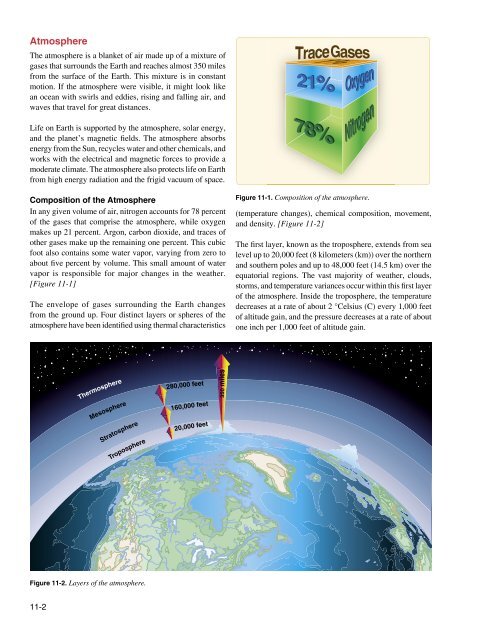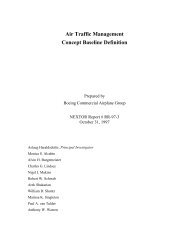AtmosphereThe atmosphere is a blanket of air made up of a mixture ofgases that surrounds the Earth and reaches almost 350 milesfrom the surface of the Earth. This mixture is in constantmotion. If the atmosphere were visible, it might look likean ocean with swirls and eddies, rising and falling air, andwaves that travel for great distances.Life on Earth is supported by the atmosphere, solar energy,and the planet’s magnetic fields. The atmosphere absorbsenergy from the Sun, recycles water and other chemicals, andworks with the electrical and magnetic forces to provide amoderate climate. The atmosphere also protects life on Earthfrom high energy radiation and the frigid vacuum of space.1%21%78%OxygenNitrogenComposition of the AtmosphereIn any given volume of air, nitrogen accounts for 78 percentof the gases that comprise the atmosphere, while oxygenmakes up 21 percent. Argon, carbon dioxide, and traces ofother gases make up the remaining one percent. This cubicfoot also contains some water vapor, varying from zero toabout five percent by volume. This small amount of watervapor is responsible for major changes in the weather.[Figure <strong>11</strong>-1]The envelope of gases surrounding the Earth changesfrom the ground up. Four distinct layers or spheres of theatmosphere have been identified using thermal characteristicsFigure <strong>11</strong>-1. Composition of the atmosphere.(temperature changes), chemical composition, movement,and density. [Figure <strong>11</strong>-2]The first layer, known as the troposphere, extends from sealevel up to 20,000 feet (8 kilometers (km)) over the northernand southern poles and up to 48,000 feet (14.5 km) over theequatorial regions. The vast majority of weather, clouds,storms, and temperature variances occur within this first layerof the atmosphere. Inside the troposphere, the temperaturedecreases at a rate of about 2 °Celsius (C) every 1,000 feetof altitude gain, and the pressure decreases at a rate of aboutone inch per 1,000 feet of altitude gain.ThermosphereMesosphereStratosphereTroposphere280,000 feet160,000 feet20,000 feetFigure <strong>11</strong>-2. Layers of the atmosphere.<strong>11</strong>-2
At the top of the troposphere is a boundary known as thetropopause, which traps moisture and the associated weatherin the troposphere. The altitude of the tropopause varies withlatitude and with the season of the year; therefore, it takeson an elliptical shape, as opposed to round. Location of thetropopause is important because it is commonly associatedwith the location of the jet stream and possible clear airturbulence.Above the tropopause are three more atmospheric levels. Thefirst is the stratosphere, which extends from the tropopause toa height of about 160,000 feet (50 km). Little weather existsin this layer and the air remains stable although certain typesof clouds occasionally extend in it. Above the stratosphereare the mesosphere and thermosphere which have littleinfluence over weather.Atmospheric CirculationAs noted earlier, the atmosphere is in constant motion.Certain factors combine to set the atmosphere in motion, but amajor factor is the uneven heating of the Earth’s surface. Thisheating upsets the equilibrium of the atmosphere, creatingchanges in air movement and atmospheric pressure. Themovement of air around the surface of the Earth is calledatmospheric circulation.Heating of the Earth’s surface is accomplished by severalprocesses, but in the simple convection-only model used forthis discussion, the Earth is warmed by energy radiating fromthe sun. The process causes a circular motion that resultswhen warm air rises and is replaced by cooler air.Warm air rises because heat causes air molecules to spreadapart. As the air expands, it becomes less dense and lighterthan the surrounding air. As air cools, the molecules packtogether more closely, becoming denser and heavier thanwarm air. As a result, cool, heavy air tends to sink and replacewarmer, rising air.Because the Earth has a curved surface that rotates on a tiltedaxis while orbiting the sun, the equatorial regions of the Earthreceive a greater amount of heat from the sun than the polarregions. The amount of sun that heats the Earth depends onthe time of year and the latitude of the specific region. All ofthese factors affect the length of time and the angle at whichsunlight strikes the surface.Solar heating causes higher temperatures in equatorial areaswhich causes the air to be less dense and rise. As the warmair flows toward the poles, it cools, becoming denser, andsinks back toward the surface. [Figure <strong>11</strong>-3]Figure <strong>11</strong>-3. Circulation pattern in a static environment.Atmospheric PressureThe unequal heating of the Earth’s surface not only modifiesair density and creates circulation patterns; it also causeschanges in air pressure or the force exerted by the weightof air molecules. Although air molecules are invisible, theystill have weight and take up space.Imagine a sealed column of air that has a footprint of onesquare inch and is 350 miles high. It would take 14.7 poundsof effort to lift that column. This represents the air’s weight;if the column is shortened, the pressure exerted at the bottom(and its weight) would be less.The weight of the shortened column of air at 18,000 feet isapproximately 7.4 pounds; almost 50 percent that at sea level.For instance, if a bathroom scale (calibrated for sea level)were raised to 18,000 feet, the column of air weighing 14.7pounds at sea level would be 18,000 feet shorter, and wouldweigh approximately 7.3 pounds (50 percent) less than atsea level. [Figure <strong>11</strong>-4]The actual pressure at a given place and time differs withaltitude, temperature, and density of the air. These conditionsalso affect aircraft performance, especially with regard totakeoff, rate of climb, and landings.Coriolis ForceIn general atmospheric circulation theory, areas of lowpressure exist over the equatorial regions and areas of highpressure exist over the polar regions due to a difference intemperature. The resulting low pressure allows the highpressureair at the poles to flow along the planet’s surface<strong>11</strong>-3
















